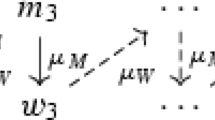Abstract
For a many-to-many matching model with contracts in which the preferences of all hospitals satisfy substitutability and the preferences of all doctors satisfy substitutability, the law of aggregate demand and q-congruence, we show the existence of a convergent blocking path. In other words, we start from an arbitrary allocation and build a finite sequence of allocations leading to a stable outcome, with the special feature that each allocation can be obtained from the previous one by satisfying a unilateral or a bilateral blocking contract. As a consequence, we prove that the process of allowing randomly selected blocks to be satisfied eventually leads to a stable outcome. This explains the fact that some markets with contracts reach stable assignments by means of decentralized decisions.

Similar content being viewed by others
Notes
Gale and Shapley (1962) defined the pioneering Deferred Acceptance Algorithm.
In terms of contracts, the preferences of an agent \(f\in F\) satisfy \(q_{f}\)-responsiveness, where \(q_{f}\) is a nonnegative integer number, if:
-
(i)
For every pair of contracts \(x,y\in {\mathbf {X}}_{f},\) and every \( S\subseteq {\mathbf {X}}_{f}{\setminus } \{x,y\}\) with \(\mid S\mid <q_{f}\), we have
$$\begin{aligned} S\cup \{x\}\succeq _{f}S\cup \{y\}\text { if and only if }\{x\}\succeq _{f}\{y\} \end{aligned}$$whenever \(S\cup \{x\}\) and \(S\cup \{y\}\) are allocations.
-
(ii)
For every contract \(x\in {\mathbf {X}}_{f},\) and every \(S\subseteq \mathbf { X}_{f}{\setminus } \{x\}\) with \(\mid S\mid <q_{f}\), we have,
$$\begin{aligned} S\cup \{x\}\succeq _{f}S\text { if and only if }\{x\}\succeq _{f}\varnothing ; \end{aligned}$$whenever \(S\cup \{x\}\) is an allocation.
-
(iii)
For all \(S\subseteq {\mathbf {X}}_{f}\) such that \(\mid S\mid >q_{f}\), we have \(\varnothing \succeq _{f}S\).
-
(i)
Note that the allocation \(Y\subseteq {\mathbf {X}},\) is individually rational if \(C_{f}\left( Y\right) =Y_{f}\) for every \(f\in F\).
\(Y\in A({\mathbf {X}})\) is a pairwise-stable allocation if
-
(i)
Y is individually rational;
-
(ii)
There does not exist \(x\in {\mathbf {X}}\backslash Y\) such that \(x\in C_{x_{D}}\left( Y\cup \left\{ x\right\} \right) \cap C_{x_{H}}\left( Y\cup \left\{ x\right\} \right) \).
-
(i)
Symmetrically, or each \(h\in H,\) \(J\subseteq F\) and \(Y\in A\left( {\mathbf {X}} \right) \) let \(I_{J}(h,Y)\) denote the set of all contracts connecting h with a doctor contained in J, wanted by the corresponding doctor if the contracts in Y are also available. This is
$$\begin{aligned} I_{J}(h,Y)=\left\{ x\in {\mathbf {X}}_{h}:x_{D}\in J \ and \ x\in C_{x_{D}}(Y\cup \left\{ x\right\} )\right\} \ . \end{aligned}$$Because of substitutability, if Z is a blocking set of the allocation Y, then \(\left\{ z\right\} \) is a blocking set of the allocation Y for all \( z\in Z\backslash Y\) .
Gale and Shapley (1962)
Doctor quasi-stability is called Inclusion Property for Doctors in Pepa Risma (2015).
By definition of DOA, the output the last iteration is equal to the output of the last-but-one iteration.
Observe that \(\left\{ z_{i}\right\} \) is a blocking set for \(X^{i-1}\). Indeed, from the construction of \(\left\{ X^{i}\right\} _{i=0}^{n},\) it follows that \(z_{i}\notin X^{i-1}\); and \(z_{i}\in C_{D}(X\cup Z)\cap C_{H}\left( X\cup Z\right) \) implies \(z_{i}\in C_{D}(X^{i-1}\cup \left\{ z_{i}\right\} )\cap C_{H}\left( X^{i-1}\cup \left\{ z_{i}\right\} \right) \) because all agents have substitutable preferences.
If \(y\in Y^{1}{\setminus } Y\) and \(f\in H,\) it follows that \(y\in S\subseteq I_{ {\overline{J}}}(f,Y)\). If \(y\in Y^{1}{\setminus } Y\) and \(f\in D,\) we have \(y\in C_{d}\) \(\left( Y\cup Y\right) ,\) and hence \(y\in C_{d}\) \(\left( Y\cup \left\{ y\right\} \right) \) due to substitutability.
References
Blum Y, Roth A, Rothblum U (1997) Vacancy chains and equilibration in senior-level. Labor markets. J Econ Theory 76:362–411
Cantala D (2003) Restabilizing matching markets at senior level. J Econ Theory 103:429–443
Gale D, Shapely LS (1962) College admissions and the stability of marriage. Am Math Mon 69:9–15
Hatfield J, Milgrom P (2005) Matching with contracts. Am Econ Rev 95(4):913–935
Hatfield J, Kominers S (2016) Contract design and stability in many-to-many matching. Games Econ Behav. https://doi.org/10.1016/j.geb.2016.01.002
Klaus B, Walzl M (2009) Stable many-to-many matching with contracts. J Math Econ 45(7–8):422–434
Knuth D (1976) Marriages stables. Les Presses de l’Universite de Montréal, Montréal
Kojima F, Ünver U (2008) Random paths to pairwise stability in many to many matching problems: a study on market equilibration. Int J Game Theory 36:473–488
Ma J (1996) On randomized matching mechanisms. Econ Theory 8:377–381
Pepa Risma E (2015) A deferred-acceptance algorithm with contracts. J Dyn Games 2(2). https://doi.org/10.3934/jdg.2015005
Roth A, Vande Vate J (1990) Random paths to stability in two sided matching. Econometrica 58(6):1475–1480
Roth A (1986) On the allocation of residents to rural hospitals: a general property of two sided matching markets. Econometrica 24:425–427
Sotomayor M (1996) A non-constructive elementary proof of the existence of stable marriages. Games Econ Behav 3:5–137
Acknowledgements
We are grateful to the Advisory Editor and the Reviewers for their useful recommendations in order to improve the exposition of this paper; to the members of the Game Theory Group of IMASL for their queries and comments; and to the members of GAECI for their assistant with the English writing.
Author information
Authors and Affiliations
Corresponding author
Additional information
This work is partially supported by the Universidad Nacional de San Luis, through grant 31012, and by the Consejo Nacional de Investigaciones Cient íficas y Técnicas (CONICET), through Grant PIP 112-200801-00464.
Rights and permissions
About this article
Cite this article
Millán, B., Pepa Risma, E. Random path to stability in a decentralized market with contracts. Soc Choice Welf 51, 79–103 (2018). https://doi.org/10.1007/s00355-018-1108-6
Received:
Accepted:
Published:
Issue Date:
DOI: https://doi.org/10.1007/s00355-018-1108-6




